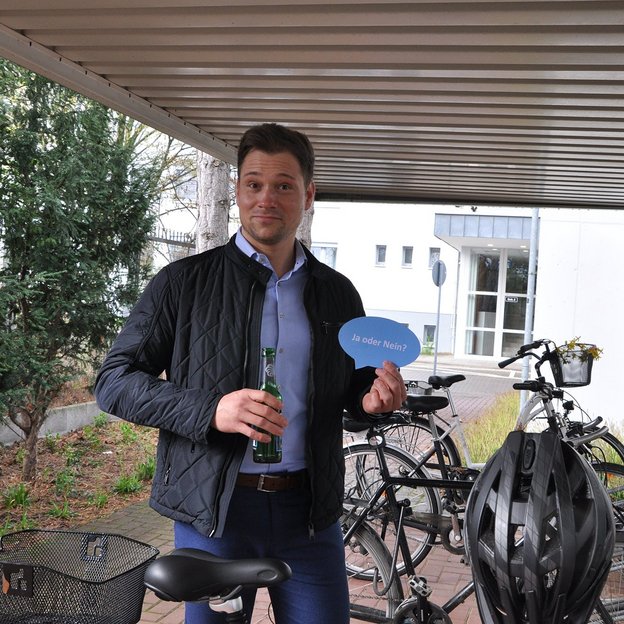At what blood alcohol level can you no longer ride a bike?
A few years ago, the University Hospital of Düsseldorf invited people to take part in an unusual experiment on behalf of the German Insurers Accident Research.

A few years ago, the University Hospital of Düsseldorf invited people to take part in an unusual experiment on behalf of the German Insurers Accident Research.

A few years ago, the University Hospital of Düsseldorf invited people to take part in an unusual experiment on behalf of the accident research department of the insurance industry – a drinking session in the service of science. During the experiment, volunteers were to repeatedly prove their ability to drive a bicycle under medical supervision. However, for some of them, the experiment ended prematurely.
The bar opened at 1 p.m. Beer, wine, schnapps, herb liqueur, rum and vodka were on offer, along with a buffet – all on the house. Several dozen volunteers were invited to get systematically drunk in the service of science. The research question: At what level of alcoholisation can we assume “absolute inability to drive” on a bicycle?
“Currently, cycling is prohibited from a blood alcohol concentration of 0.16 percent,” explains Dr. Ralf Buchstaller of TÜV NORD. ‘However, anyone who has an accident or drives unsafely is liable to prosecution from as little as 0.03 percent.’ The consequences: a fine, points on your license and, if you want to keep your driving license, a driving aptitude test in the form of a medical-psychological examination (MPU).
To test the limit values for their practical validity, the Düsseldorf Institute for Forensic Medicine ensured that the conditions were as realistic as possible. The then director of the institute, Thomas Daldrup, who has since retired, and his co-authors had more than a dozen helpers: from doctors to cameramen and police officers to road maintenance crews.
The 74 volunteers were men and women between the ages of 18 and 53 who could ride a bike, had a medical certificate, and indicated 'experience in consuming alcohol'. To prevent injuries, they were provided with helmets and protective clothing and given special bicycles with training wheels that would touch the ground if they tipped over. They were also allowed to do as many practice laps as they needed.
After the sober volunteers had passed their first driving test, the beer started flowing. The alcohol level in the breath was checked repeatedly, and when certain limit values were reached, blood samples were taken, eye tests performed and a lap around the course, including slalom poles, an alley of plastic barrels and complicated by unpredictable situations such as a blocked lane. The rides were recorded on video and any driving errors such as weaving and collisions were recorded.
Most of the test subjects managed five out of six possible trips. The fastest drinker reached a blood alcohol level of 2.27 before his fourth attempt, and had to be stopped: “Completely uncontrolled driving without observing traffic signs or lanes,” noted the 2014 final report. Two other heavily intoxicated volunteers behaved so aggressively that they had to be taken home. And four people broke off prematurely because they felt unwell.
However, the majority completed the course multiple times with steadily increasing alcohol levels. The first driving errors occurred at 0.2 to 0.4 per mille, and gross driving errors occurred at 0.8 per mille. At 1.1 per mille, driving errors increased exponentially, and at 1.4 per mille, all subjects drove worse than when sober. However, some of the test subjects still made fewer mistakes than the average sober driver beyond 1.6 per mille. Judge and co-author Kurt Rüdiger Maatz concludes from this that a legal limit for “absolute” driving insecurity below 1.6 per mille cannot be justified. However, there is a risk from as little as 0.15, and from 0.08 it is justified to 'warn' of the danger.
A similar experiment at the University of Mainz, conducted in the same year, came to comparable conclusions, and the German Center for Health Education confirms the limit values. According to the study, concentration and judgment, vision and reaction time suffer at just 0.3 per mille, and at 0.8 per mille, the field of vision is narrowed by a quarter. “At the same time, you feel liberated from inhibitions and worries and tend to overestimate yourself,” warns Ralf Buchstaller of TÜV NORD.
Unlike driving, drunk cycling is primarily a danger to the drunk themselves. A clinic in Finland examined emergency cases involving cyclists over a two-year period and found that around a third of them had been drinking at the time of their admission. Of these, 60 percent had head injuries, twice as many as among those who had not been drinking.
“According to international estimates, 15 to 57 percent of those who have an accident while cycling are intoxicated,” reports a team from the University of Groningen. In their own study, they tested the alcohol content in the breath of almost 700 cyclists in Groningen and The Hague. For around two-thirds of them, the measuring device showed at least 0.5 per mille at one o'clock in the morning.
Dr. Ralf Buchstaller, a psychologist, therefore advises planning your way home in good time: “When you're drunk, you often no longer realistically assess your own driving ability.” Many people have already experienced at first hand that a nice evening can end badly otherwise - like the volunteers in the Düsseldorf experiment. “But at least they were wearing protective gear and were under medical supervision,” recalls Ralf Buchstaller from TÜV NORD. “So please don't try this at home!”
Founded over 150 years ago, we stand for security and trust worldwide. As a knowledge company, we have our sights firmly set on the digital future. Whether engineers, IT security experts or specialists for the mobility of the future: in more than 100 countries, we ensure that our customers become even more successful in the networked world.